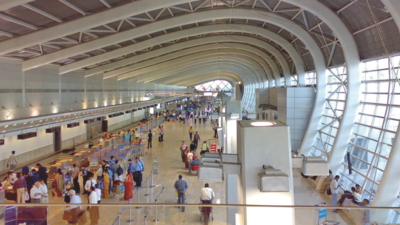- News
- City News
- navi mumbai News
- Mumbai airport's terminal 1 to shut this year, 10 million flyers to shift to Navi Mumbai
Trending
Mumbai airport's terminal 1 to shut this year, 10 million flyers to shift to Navi Mumbai
Navi Mumbai airport will begin operations in late May and is projected to become the primary airport in the Mumbai Metropolitan Region by the early 2030s. It will handle most flights, with Mumbai airport taking on a secondary role. The new airport will continue to expand, aiming for a capacity of 90 million passengers per annum by 2036.
MUMBAI: Passengers will face a clear choice when the Navi Mumbai airport begins operations in late May: should they select the new airport or continue using the one in Mumbai? However, within a decade, this choice will become less pronounced as the Navi Mumbai airport takes the lead. According to projections, by the early 2030s, it should handle most flights in the Mumbai Metropolitan Region (MMR), becoming its primary airport, with the Mumbai airport assuming a secondary role.
Poll
What’s the Most Annoying Part of Traveling Through Airports?
This winter, though, only about one-fifth of the 55 million passengers currently handled by the Mumbai airport will head to the Navi Mumbai airport. Of the 15 million passengers handled by Mumbai’s Terminal 1 (T1) at Santacruz (East), flights carrying 10 million passengers are likely to shift to T1 of NMIA by the end of October, while the remaining 5 million will be accommodated at Mumbai’s Terminal 2 (T2) in Sahar, said an NMIA official. To accommodate this shift, the capacity of Mumbai T2 will be increased from 40 million to 45 million passengers, the source added.
Currently, all flights—domestic and international—land on the single operational runway at Mumbai airport, after which passengers are transported to their respective terminals, T2 or T1. Most general aviation flights, including private and charter aircraft, will also transition to the Navi Mumbai airport in the coming months. This winter, air traffic congestion at the Mumbai airport is expected to ease, improving its punctuality record. As a result, the holding time for flights waiting to land at Mumbai airport or the waiting time to begin pushback for departures is likely to decrease, improving on-time performance.
In the long term, the busy and congested Mumbai airport will take the number two position as MMR’s secondary airport. The world’s great cities are usually served by multiple airports, with one being the main airport and the others serving as secondary airports. For example, in London, Heathrow is the busiest airport, while Gatwick, Stansted, and Luton serve as secondary airports. Similarly, New York’s main airport is John F. Kennedy, with Newark Liberty and LaGuardia functioning as secondary airports.
The current Mumbai airport handled 55 million passengers in 2024. It will remain Mumbai’s Heathrow this decade, during which the new Navi Mumbai airport at Ulwe will serve as the metropolis’s Gatwick, expected to handle around 10 million passengers this year and 20 million by mid-2026.
The Navi Mumbai T1 has a declared passenger handling capacity of 20 million ppa, or about 55,000 per day. It is expected to reach saturation point by mid-2026—probably the shortest saturation time in the world for a greenfield airport terminal. Navi Mumbai T2, with a declared capacity of 30 million ppa, will be ready by 2029. “Between 2026 and 2029, Mumbai T2 and Navi Mumbai T1 terminal buildings will be expanded to exceed their declared capacity in order to handle the passenger traffic growth,” the official added.
The new airport will continue expanding, adding terminal buildings and increasing capacity. It will continue to resemble a construction site for years, as work progresses across its 2,860 acres over the next decade.
The congested Mumbai airport will struggle to keep pace with the growth of the Navi Mumbai airport, and by 2030, both airports will handle over 50-55 million PPA each, competing closely. But as the Navi Mumbai airport continues to expand, a role reversal will occur by 2032: it will take on the mantle of the region’s main airport—its Heathrow—complete with parallel runways. In 2032, the Navi Mumbai airport will have its Terminal 3, with a capacity of 20 million PPA, and later Terminal 4 in 2036, also with a 20-million PPA capacity. This will take Navi Mumbai airport’s capacity to 90 million PPA, a number that the congested Mumbai airport cannot match. Mumbai airport, much like Gatwick in London with its single runway, will become the region’s secondary airport.
BVJK Sharma, CEO of Navi Mumbai International Airport, said: “The Navi Mumbai airport is well supported by multimodal connectivity, and we are confident in meeting MMR’s ever-increasing demand. I am positive that the airport will contribute greatly to the region’s and country’s growth.”
The final stage of this competition between the two airports will mark a major decline for Mumbai airport, which was India’s busiest until 2010. Hemmed in by slums and without the possibility of land acquisition, the Mumbai airport hasn’t been able to expand. With infrastructure constraints stifling its growth, Delhi airport has surpassed it to claim the top spot among the country’s airports, a rank that the National Capital Region will continue to occupy.
The Navi Mumbai airport will not restore the Mumbai Metropolitan Region's position as the leader in this category, as Delhi airport, along with the new Jewar airport—which is also set to open this year—will have a higher passenger-handling capacity than Mumbai and Navi Mumbai combined.
End of Article
FOLLOW US ON SOCIAL MEDIA
Visual Stories
Hot Picks
TOP TRENDING
Explore Every Corner
Across The Globe





















